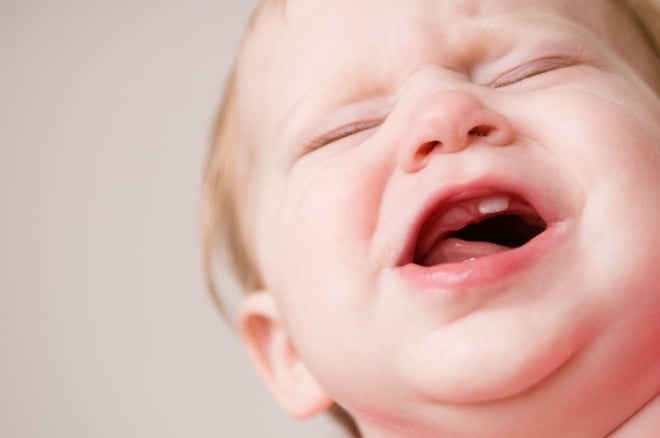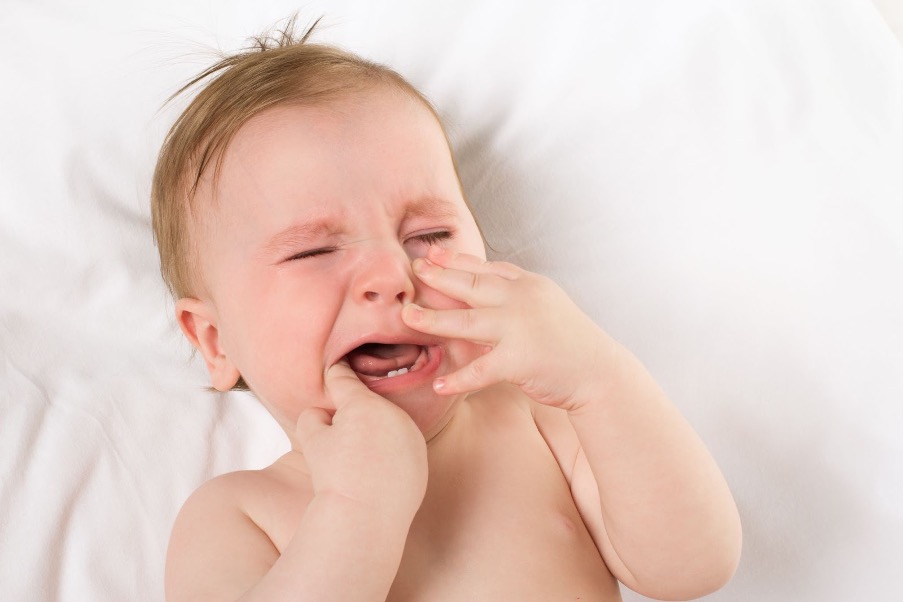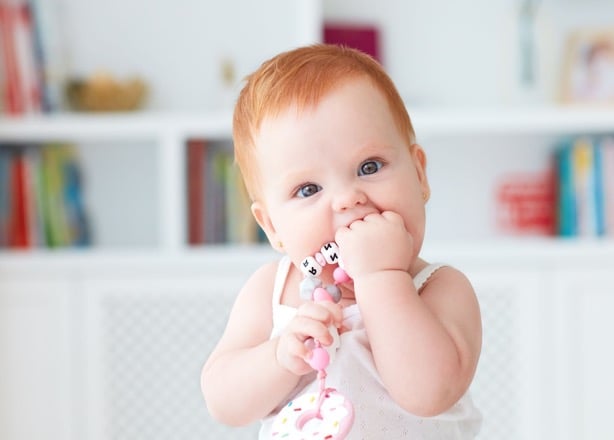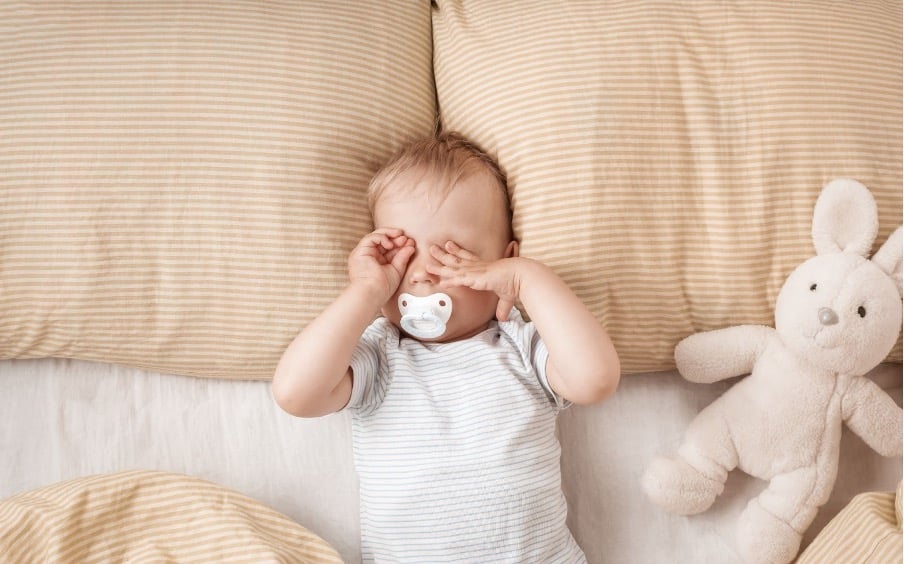Teething can be a very unsettling and painful experience for your baby, and it can be difficult to know how to soothe your baby, particularly during the night.
To help support you and your baby through this, our expert midwives have gathered the most up-to-date advice to give you the lowdown on:
- The signs your baby is teething
- When teething starts
- Teething and sleep problems
- Tips for soothing a teething baby
- How to soothe a teething rash
- The importance of maintaining a bedtime routine
Signs your baby is teething
Before you know it, your newborn baby is growing and may be showing signs of teething.
Babies are all individuals and will cut their teeth at different ages, but recognising signs and symptoms and being able to help soothe your baby will help you cope with what can be an upsetting and stressful time.
You may notice some or all of these common signs of teething:
- Crying more than usual
- Irritability, fussiness and grizzling
- Excessive drooling and rash around baby’s mouth and chin - check out our Totally Immense Dribble Defence for this
- Chewing on their fists, toys or even you
- Flushed red cheeks
- Waking more frequently at night or during daytime naps
- Difficulty settling or being soothed
- Tugging or rubbing their ears
- May be off their feeds
- Swollen, red gums
- Nappy rash - check out our No Harm Bum Balm for this
- Runny noses

When does teething start?
Usually, a baby’s first tooth emerges anytime between 4-12 months old. Although, this can also happen earlier or later. Some babies wake up having cut a new tooth overnight, while others have symptoms for weeks and still struggle to get teeth through.
There is no way of telling how your baby will cope with teething, but identifying teething symptoms and understanding how to soothe your teething baby can help you both.
Most babies are born without teeth, but less than 1% will have one or more natal teeth (teeth present at birth) or neonatal teeth (teeth that emerge during the first month). These will need examination by a neonatologist or paediatric dentist, who will consider if they need removing.
Some babies will have a full set of teeth before they are 18 months old, whilst others will be three years or older before they have all 20 milk teeth through!
So, let’s look at a rough timeline of teething in babies. Although this varies from baby to baby, don’t worry if your baby differs from this.
- Central incisors lower jaw (lower front teeth) → 4-12 months
- Central incisors upper jaw (upper front teeth) → 6-12 months
- Lateral incisors upper jaw (upper side teeth) → 8-14 months
- Lateral incisors lower jaw (lower side teeth) → 9-16 months
- Molars, upper and lower jaws → 12-36 months
- Canines, upper and lower jaws → 16-24 months
Incisors are usually the first and easiest teeth to cut because they are smaller and thinner than the rest.
Molars are larger and broader than incisors. They often appear bulging through the gum, making your baby’s gum red and quite sore. Molars tend to cause typical teething symptoms.
Canine teeth are between molars and incisors, being pointier and narrower than molars yet larger than incisors, so you may still find your baby troubled by them but less so than by their molars.
Is teething causing sleeping problems?

If your baby is waking at night because of teething, they will likely display some of the symptoms and signs discussed above. Otherwise, it could be that something else is causing them to wake up.
Baby sleep disturbance has been cited in many teething research papers. But the good news is that this kind of waking is usually short-lived, lasting 1-5 days as opposed to weeks when associated with other causes of sleeping problems.
See our article on helping your baby sleep through the night for more sleep tips.
We would advise that you contact your GP or seek urgent advice from 111, 999 or A&E if:
- Your baby is waking up with a fever
- Your baby is waking with a rash
- Your baby has persistent vomiting or diarrhoea
- This waking has continued for more than seven days, and there are no other teething symptoms
Tips for helping a teething baby
When your baby is teething, they may need some help from you to relieve the discomfort and settle them back to sleep. Our midwives have some tips for teething babies that may be useful.
However, it is vital that if your suspect baby’s symptoms are due to something else, such as an ear infection, you speak with your GP for further advice.
You may find that your baby is more unsettled and fussier during the night when busy daytime activities aren’t distracting them, and this can be tough on you both. So, finding things that bring some relief can be a real saviour.
Follow these tips to help relieve your baby’s teething pain.
Massage the gums
Using a clean finger, a soft cloth or a teething ring, gently massage the affected area using a circular motion. If the baby shows distress, use a lighter touch or stop, as it may be too painful for them.
Cool the gums
Use a soft cloth dipped in cold water, a cold teething ring or a teething toy cooled in the fridge to chew on. The cold has a soothing effect on sore gums and provides some temporary pain relief.Provide something safe to chew on
Offer a clean finger to chomp on or a specially designed teething toy. But ensure they are baby-safe products and that no damaged bits could be a choking hazard.Apply gentle pressure to the gums
Like gum massage and chewing, pressure on your baby’s gums may give relief. Ensure your fingers are clean, and simply press gently on the affected areas. This is more static than gum massage and is localised to the area where you can see a tooth is trying to cut through.Play white noise or classical music
White noise and classical music are commonly used to help relax babies. A washing machine, hairdryer, white noise app or gentle classical music can really help to settle your baby back to sleep, or just soothe them if they are fractious. If they have a particular sound or sounds that usually settle them, make sure you have this to hand during the day and overnight..Assess pain relief options
Like gum massage and chewing, pressure on your baby’s gums may give relief. Ensure your fingers are clean, and simply press gently on the affected areas. This is more static than gum massage and is localised to the area where you can see a tooth is trying to cut through.
Cuddling
Babies need to feel loved and safe to feel relaxed. So pick them up, cuddle them tightly, or even try skin-to-skin so they feel your warmth and heartbeat and can smell you. This comfort is proven to soothe babies and regulate their breathing, heart rate and temperature.Increase their fluids
Excessive dribbling can cause dehydration, especially during warmer weather, so offer plenty of extra breastfeeds or fluids. You may find cold water provided in a cup or a bottle helps to soothe painful gums.
Keeping babies hydrated also prevents their urine from becoming overly concentrated, which can cause their nappy area to become sore, cracked, and infected.
Treat and prevent the pain and discomfort caused by dribble rash
Babies who suffer discomfort and pain from teething usually dribble, and excessively so. Dribbling makes the skin wet and sore if not cleaned and dried regularly, especially at night.
Use an expertly developed product, such as Totally Immense Dribble Defence, to calm and soothe inflamed skin and create a protective barrier against the dribble. When your baby is teething, use it regularly to help to prevent teething rashes and irritation.
How to soothe a teething rash around a baby's mouth?
Baby dribble contains digestive enzymes which break down the protective layer on their skin, leaving the skin open to chafing, irritation, and damage. If your baby has developed a teething rash around their mouth or sore skin on their cheeks or neck from dribbling due to teething, keep the area clean and dry to help prevent it from worsening and potentially becoming infected.
You can soothe, nourish and protect your baby’s skin with a good skin barrier cream which creates a calming barrier for the skin.
Applying a thin layer of a barrier product to the face, chin, neck, and chest before bed can help to protect the baby’s skin overnight.
How to help a teething baby sleep better

Maintaining a sleep routine is key to helping your teething baby sleep. Keeping things as normal as possible for the baby can prevent them from becoming even more unsettled and may help prevent night disturbances from becoming a habit.
When putting baby to bed, follow their regular bedtime routine, and if they wake during the night, try the tips advised by our midwives:
- Keep the environment quiet by talking in a lower voice
- Keep lighting low
- Keep them settled in their own sleeping space whenever possible
- Pick them up if they are distressed or upset
If you hear your baby wake up, but they are not crying, give them some time to settle themselves back down before going to them. Babies with good bedtime routines often cope better through the night when they are teething. The good news is that sleep disturbance from teething is usually short-lived, usually lasting just 3-5 days (or nights).
Key takeaways
Teething babies may wake at night, but this sleep disturbance usually only lasts a few days. Following a few simple tips can help keep disruptions to a minimum and help you and your baby through this developmental stage.
A good baby barrier cream product can help prevent and soothe teething rashes around the chin and mouth. Shop our specially-formulated Totally Immense Dribble Defence barrier cream today, developed by our expert midwives.



















